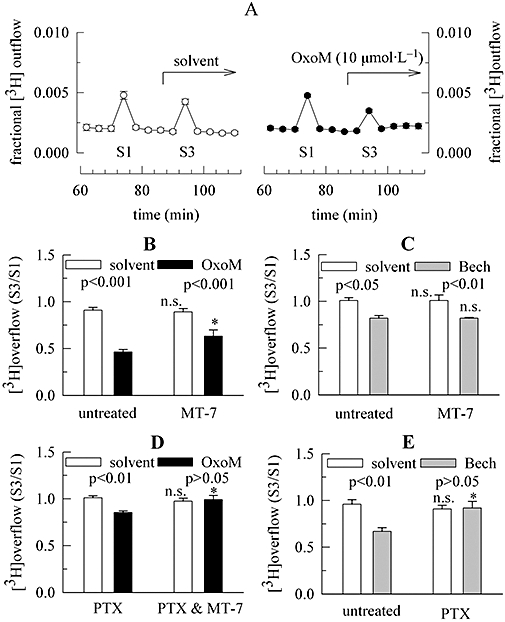Figure 4.

Characterization of the inhibition of K+-evoked noradrenaline release via mAChRs in the presence of TTX. Primary cultures of rat SCG neurons were either treated with pertussis toxin (PTX; 100 ng·mL−1 for 24 h) or remained untreated. Cultures were then labelled with [3H]-noradrenaline for 1 h in the absence or presence of 100 nmol·L−1 MT-7 and were superfused. From 50 min of superfusion onward, 0.1 µmol·L−1 TTX was present. Subsequent to a 60 min washout period, 4 min fractions of superfusate were collected. KCl 30 mmol·L−1 (NaCl was reduced accordingly) was present at 73 (S1) and 93 (S3) min of superfusion. OxoM 10 µmol·L−1 or 100 µmol·L−1 bethanechol (Bech) was present as indicated by the arrow; as a control for statistical comparison, solvent was applied instead of OxoM or bethanechol. (A) The time course of fractional 3H outflow·min−1 and its alteration by 10 µmol·L−1 OxoM on the right hand side (n= 3). For comparison, the effect of solvent is depicted on the left hand side (n= 3). (B) The inhibition of K+-evoked tritium overflow (as exemplified by S3/S1 ratios) by 10 µmol·L−1 OxoM in either untreated or MT-7-treated cultures; its effect is compared with that of solvent (n= 9). (C) The inhibition of K+-evoked tritium overflow (as exemplified by S3/S1 ratios) by 100 µmol·L−1 bethanechol in either untreated or MT-7-treated cultures; its effect is compared with that of solvent (n= 6). (D) The inhibition of K+-evoked tritium overflow (as exemplified by S3/S1 ratios) by 10 µmol·L−1 OxoM in cultures treated either with PTX or with PTX plus MT-7; the effect of OxoM is compared with that of solvent (n= 8 to 9). (E) The inhibition of K+-evoked tritium overflow (as exemplified by S3/S1 ratios) by 100 µmol·L−1 bethanechol in either untreated or PTX-treated cultures; the effect of bethanechol is compared with that of solvent (n= 6). In (B) to (E), significances of differences between pairs of bars are indicated above the corresponding pairs. * Indicates a significant difference versus the corresponding results obtained in either untreated (B, C and E) or PTX-treated (D) cultures at P < 0.05; n.s. indicates the lack of such a significance. mAChRs, muscarinic acetylcholine receptors; MT-7, muscarinic toxin 7; OxoM, oxotremorine M; PTX, pertussis toxin; SCG, superior cervical ganglia; TTX, tetrodotoxin.
